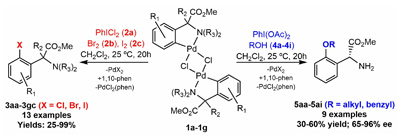|
Orthopalladated derivatives from substituted phenylglycines [Pd(μ-Cl)(C6H3R1C(R2)(R3)N(R4)2]2 (1) react with halogenating reagents (PhICl2, Br2, I2) (2) to give the corresponding o-halogenated amino acids C6H3(X)R1C(R2)(R3)N(R4)2 (3). The reaction is general and tolerates a variety of functional groups (R1 to R4) at the aryl ring, the Cα, and the N atom. On the other hand, the reaction of [Pd(μ-Cl)(C6H3R1C(R2)(R3)N(R4)2]2 (1) with PhI(OAc)2 in the presence of a variety of alcohols R5OH (4) gives the o-alkoxylated phenylglycines C6H3(OR5)R1C(R2)(R3)N(R4)2 (5), also as a general process. A partial loss of the enantiomeric excess is observed when the starting phenylglycine is enantiomerically pure, this arising from the formation of bridging azavinylidene (6) and imine intermediate species (7), which were characterized by X-ray diffraction methods.
|

